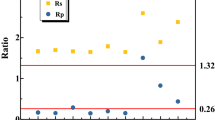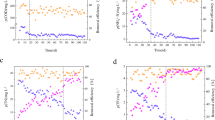Abstract
Implementation of biological ammonia-to-nitrite conversion (nitritation) is crucial to more sustainable municipal wastewater treatment. However, achieving stable nitritation, especially in low-temperature mainstream municipal wastewater, remains a global challenge. Here we develop a loading rate switch strategy to enable ultrastable nitritation in a pilot-scale (6.5 m³) reactor treating real mainstream municipal wastewater. This strategy consists of a stage with high organic loading rate to decrease both ammonia-oxidizing bacteria and nitrite-oxidizing bacteria amounts and a stage in which the organic loading rate sharply decreases to enhance ammonia-oxidizing bacteria and promote their bioactivity while containing nitrite-oxidizing bacteria. By implementing this strategy, nitritation initiated within 7 days and a high nitrite accumulation ratio of ~98.1% was maintained for >450 days, even at temperature as low as 5.9 °C. During the long-term operation, nitrite-oxidizing bacteria were below the detection level, whereas ammonia-oxidizing bacteria remained abundant. Moreover, the average concentrations of effluent ammonium and nitrite were kept at 8.3 and 13.8 mg N l−1, respectively, favouring further nitrogen removal by anammox process, an inherently low-carbon and low-energy process. Overall, this work presents a viable and environmentally friendly strategy for nitrogen removal, paving the way to sustainable sewage management.
This is a preview of subscription content, access via your institution
Access options
Access Nature and 54 other Nature Portfolio journals
Get Nature+, our best-value online-access subscription
$29.99 / 30 days
cancel any time
Subscribe to this journal
Receive 12 digital issues and online access to articles
$119.00 per year
only $9.92 per issue
Buy this article
- Purchase on Springer Link
- Instant access to full article PDF
Prices may be subject to local taxes which are calculated during checkout






Similar content being viewed by others
Data availability
The data that support the findings of this study are available from the corresponding author. The raw sequence data from this study have been archived in NCBI Sequence Read Archive (SRA) with the project accession number of PRJNA905363.
Code availability
All computer codes generated during this study are available from the corresponding authors.
References
Lu, L. et al. Wastewater treatment for carbon capture and utilization. Nat. Sustain. 1, 750–758 (2018).
Kartal, B., Kuenen, J. G. & van Loosdrecht, M. C. M. Sewage treatment with anammox. Science 328, 702–703 (2010).
Strous, M. et al. Missing lithotroph identified as new planctomycete. Nature 400, 446–449 (1999).
Kartal, B. et al. Molecular mechanism of anaerobic ammonium oxidation. Nature 479, 127–130 (2011).
Speth, D. R., in’t Zandt, M. H., Guerrero-Cruz, S., Dutilh, B. E. & Jetten, M. S. M. Genome-based microbial ecology of anammox granules in a full-scale wastewater treatment system. Nat. Commun. 7, 11172 (2016).
Joss, A. et al. Combined nitritation–anammox: advances in understanding process stability. Environ. Sci. Technol. 45, 9735–9742 (2011).
Hou, F. et al. Partial anammox achieved in full scale biofilm process for typical domestic wastewater treatment. Front. Environ. Sci. Eng. 16, 33 (2022).
Guo, Y., Luo, Z., Shen, J. & Li, Y. The main anammox-based processes, the involved microbes and the novel process concept from the application perspective. Front. Environ. Sci. Eng. 16, 84 (2022).
Regmi, P. et al. Control of aeration, aerobic SRT and COD input for mainstream nitritation/denitritation. Water Res. 57, 162–171 (2014).
Ma, B. et al. Biological nitrogen removal from sewage via anammox: recent advances. Bioresour. Technol. 200, 981–990 (2016).
Mulder, J. W., van Loosdrecht, M. C. M., Hellinga, C. & van, K. R. Full-scale application of the SHARON process for treatment of rejection water of digested sludge dewatering. Water Sci. Technol. 43, 127–134 (2001).
Hellinga, C., Schellen, A. A. J. C., Mulder, J. W., van Loosdrecht, M. C. M. & Heijnen, J. J. The SHARON process: an innovative method for nitrogen removal from ammonium-rich waste water. Water Sci. Technol. 37, 135–142 (1998).
Wang, Z., Zheng, M., Duan, H., Yuan, Z. & Hu, S. A 20-year journey of partial nitritation and anammox (PN/A): from sidestream toward mainstream. Environ. Sci. Technol. 56, 7522–7531 (2022).
Blackburne, R., Yuan, Z. & Keller, J. Demonstration of nitrogen removal via nitrite in a sequencing batch reactor treating domestic wastewater. Water Res. 42, 2166–2176 (2008).
Wang, Z. et al. Rapid initiation and stable maintenance of municipal wastewater nitritation during the continuous flow anaerobic/oxic process with an ultra-low sludge retention time. Water Res. 197, 117091 (2021).
Li, S. et al. Rapid achieving partial nitrification in domestic wastewater: controlling aeration time to selectively enrich ammonium oxidizing bacteria (AOB) after simultaneously eliminating AOB and nitrite oxidizing bacteria (NOB). Bioresour. Technol. 328, 124810 (2021).
Wang, D. et al. Achieving stable nitritation for mainstream deammonification by combining free nitrous acid-based sludge treatment and oxygen limitation. Sci. Rep. 6, 25547 (2016).
Wu, P. et al. Fast start-up of the cold-anammox process with different inoculums at low temperature (13 °C) in innovative reactor. Bioresour. Technol. 267, 696–703 (2018).
Luo, S., Peng, Y., Liu, Y. & Peng, Y. Research progress and prospects of complete ammonia oxidizing bacteria in wastewater treatment. Front. Environ. Sci. Eng. 16, 123 (2022).
Liu, G. & Wang, J. Long-term low DO enriches and shifts nitrifier community in activated sludge. Environ. Sci. Technol. 47, 5109–5117 (2013).
Wang, B. et al. Recovering partial nitritation in a PN/A system during mainstream wastewater treatment by reviving AOB activity after thoroughly inhibiting AOB and NOB with free nitrous acid. Environ. Int. 139, 105684 (2020).
Sun, T., Du, R., Dan, Q., Liu, Y. & Peng, Y. Rapidly achieving partial nitrification of municipal wastewater in enhanced biological phosphorus removal (EBPR) reactor: effect of heterotrophs proliferation and microbial interactions. Bioresour. Technol. 340, 125712 (2021).
Zheng, M. et al. Critical factors facilitating Candidatus nitrotoga to be prevalent nitrite-oxidizing bacteria in activated sludge. Environ. Sci. Technol. 54, 15414–15423 (2020).
Rubio-Rincon, F. J., Lopez-Vazquez, C. M., Welles, L., van Loosdrecht, M. C. M. & Brdjanovic, D. Cooperation between Candidatus Competibacter and Candidatus Accumulibacter clade I, in denitrification and phosphate removal processes. Water Res. 120, 156–164 (2017).
Wang, X. et al. Evaluating the potential for sustaining mainstream anammox by endogenous partial denitrification and phosphorus removal for energy-efficient wastewater treatment. Bioresour. Technol. 284, 302–314 (2019).
Li, J. et al. Successful application of anammox using the hybrid autotrophic–heterotrophic denitrification process for low-strength wastewater treatment. Environ. Sci. Technol. 56, 13964–13974 (2022).
Wang, Z. et al. Unravelling adaptation of nitrite-oxidizing bacteria in mainstream PN/A process: mechanisms and counter-strategies. Water Res. 200, 117239 (2021).
Rice, E. W., Baird, R. B., Eaton, A. D. & Clesceri, L. S. Standard Methods for the Examination of Water and Wastewater (American Public Health Association, American Water Works Association and Water Environment Federation, 2012).
Song, Y. et al. Architecture of HAP-anammox granules contributed to high capacity and robustness of nitrogen removal under 7°C. Water Res. 206, 117764 (2021).
Oehmen, A. et al. Anaerobic and aerobic metabolism of glycogen-accumulating organisms selected with propionate as the sole carbon source. Microbiology 152, 2767–2778 (2006).
Miao, Y. et al. Partial nitrification anammox (PNA) treating sewage with intermittent aeration mode: effect of influent C/N ratios. Chem. Eng. J. 334, 664–672 (2018).
Acknowledgements
This work was financially supported by the National Natural Science Foundation of China (grants 52122005 and 52131004), the National Key Research and Development Programme (2021YFC3200601 and 2021YFC3200605), R&D Program of Beijing Municipal Education Commission (grant KM202210005014) and Higher Education Discipline Innovation Project (111 project, D16003).
Author information
Authors and Affiliations
Contributions
Z.W., L.Z., W.Z. and Y.P. planned the project and provided analysis design. Z.W., Q.Z., X.L. and Y.P. participated in the experimental work. Z.W., L.Z. and Y.P. wrote the paper. J.L. polished the paper.
Corresponding author
Ethics declarations
Competing interests
The authors declare no competing interests.
Peer review
Peer review information
Nature Sustainability thanks Zheng Min and the other, anonymous, reviewer(s) for their contribution to the peer review of this work.
Additional information
Publisher’s note Springer Nature remains neutral with regard to jurisdictional claims in published maps and institutional affiliations.
Supplementary information
Supplementary Information
Supplementary Tables 1–4, Figs. 1–4 and Methods.
Rights and permissions
Springer Nature or its licensor (e.g. a society or other partner) holds exclusive rights to this article under a publishing agreement with the author(s) or other rightsholder(s); author self-archiving of the accepted manuscript version of this article is solely governed by the terms of such publishing agreement and applicable law.
About this article
Cite this article
Wang, Z., Zhang, L., Zeng, W. et al. A loading rate switch strategy for stable nitritation in mainstream municipal wastewater. Nat Sustain 7, 305–314 (2024). https://doi.org/10.1038/s41893-024-01276-z
Received:
Accepted:
Published:
Issue Date:
DOI: https://doi.org/10.1038/s41893-024-01276-z
This article is cited by
-
A fresh start to sustainable sewage nitrogen removal
Nature Sustainability (2024)



